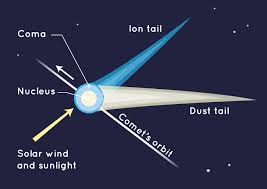Comets are fascinating celestial objects that consist mostly of ice, dust, and rocky material. They are often described as “dirty snowballs” because of their composition. When comets approach the Sun, the heat causes the ices to vaporize, forming a glowing coma (a cloud of gas and dust) and often a tail. This tail always points away from the Sun due to solar wind and radiation pressure.
Some key features of comets include:
- Nucleus: The solid core of a comet, composed mainly of ice and dust.
- Coma: A cloud of gas and dust that forms around the nucleus when the comet is heated by the Sun.
- Tail: The tail, which can be spectacularly visible from Earth, is formed by the solar wind and radiation pressure pushing gas and dust away from the comet. It can be up to millions of kilometers long.
There are two main types of comets:
- Short-period comets: These comets have orbits that take them around the Sun in less than 200 years. They typically come from the Kuiper Belt, a region of icy bodies beyond Neptune.
- Long-period comets: These comets have orbits that take them around the Sun in more than 200 years, often coming from the Oort Cloud, a distant region of icy objects far beyond Pluto.
Comets have been important in science and history, providing insights into the early solar system and sometimes sparking awe and superstition among humans. Do you have a specific comet in mind, or are you interested in a particular aspect of them?

